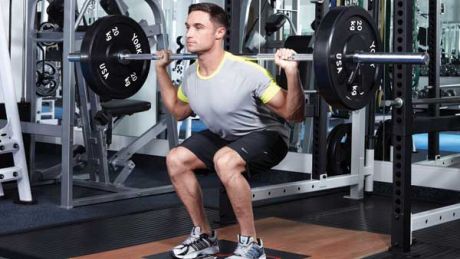Why You Should Squat
Make squats the foundation of your training programme if you want to get bigger, stronger and leaner

The back squat is one of the best exercises for everyone, whether you’re training for strength, power, body composition, marathon running or just to stay in shape. Whatever your goal, here’s what you need to know.
Go low
Never be afraid to squat all the way down. A common misconception is that when your thighs go below parallel to the floor it’s bad for your knees. Baloney. This bogus ‘rule’ comes in part from the idea that it’s bad for the knees to travel forwards over the toes. Did you realise your knees do this every time you go up and down stairs? Doing full-range-of-motion squats can improve strength, power, hypertrophy, functional mobility and knee joint strength, which will safeguard against injury.
Fix your VMO
The vastus medialis oblique (VMO) is the only one of the four quadriceps muscles to cross the knee and, as such, it plays a significant role in knee stability. A weak VMO renders any back squat training ineffective by affecting knee alignment and puts you at risk of injury. The one-and-one-quarter squat is a great way to correct weakness in the VMO. Here’s how to do it: squat for a five-second count until you hit the bottom position, come up a quarter of the way at a slow and deliberate pace, go back down all the way under control until your hamstrings cover your calves, then come up until your knees are short of lockout. That’s one rep.
Be balanced
Ensure better squatting by achieving structural balance between your quads and hamstrings. The most practical way to determine structural balance between these two crucial muscles is to compare your one-rep max (1RM) for the front squat to your 1RM for the back squat. If your front-squat weight is less than 85% of your back squat, you have an imbalance. Work on this to ensure you get stronger and faster and can lift more safely.
Shake things up
If you’re struggling to increase your one-rep max or failing to add muscle mass on your legs, you can overcome a plateau by doing more squat variations. Front squats are the obvious first example, because a heavy full-range front squat is excellent for training vertical acceleration and it’s an ideal way to activate the abdominals, quads and lower back. Front squats keep you honest if you’re lifting a heavy load because if you cheat you’ll probably drop the bar or get injured. Front squats also require flexibility in the hip, ankle, wrist and shoulder joints, so doing them gives you an incentive to work on range of motion, and the arm position mimics the catch position of the clean. All this practice will make you better at lifting heavier when you return to back squats.
Sort your shoes
If you are serious about getting better at squatting, it’s worth investing in a pair of weightlifting shoes. In addition to being rigid to give you a solid platform for squatting, these shoes have an elevated heel, usually about 2.5cm thick. This heel enables your shins to incline forwards further so your back can maintain a more upright position during the squat. This effect is especially valuable for those with tight calves, because they would have to lean forwards excessively when squatting to compensate. The rigid design of the shoe also helps align the bones of the ankle and foot so it’s easier to keep the knees in the proper alignment when squatting.
Form Tips
Get more out of every rep with perfect form
Sign up for workout ideas, training advice, reviews of the latest gear and more.
1 Stand tall with your feet hip-width apart, with the barbell loaded on the back of your shoulders – not on your neck – and held with a wide overhand grip.
2 Keeping your core braced and a natural arch in your back, bend your knees and lower as far as you can, controlling the weight at all times.
3 Drive your heels into the floor to initiate the return phase. Push your knees out to the side – never inwards – to return to a fully standing position.
One of the world's premier strength coaches, Charles Poliquin has successfully trained professional athletes and Olympians worldwide. Poliquin writes a monthly column for Men's Fitness about how to train as effectively as possible.

